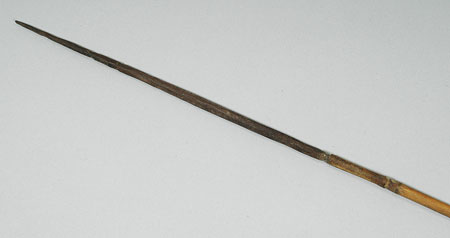Accession Number:
1944.10.75
Country:
Sudan
Region:
Blue Nile ?Darfung
Cultural Group:
?Burun
Date Made:
By 1912
Materials:
Cane Plant , Ebony Wood Plant , Animal Hide Skin
Process:
Carved , Notched , Socketed , Bound , Decorated
Dimensions:
Total L = 1068 ; arrowhead L = 284, diam = 8.5; shaft L = 784, diam = 8.5 x 8, nock L = 11, binding L = 10, W = 3 mm [RTS 27/5/2005].
Weight:
32.7 g
Other Owners:
L. Gorringe and Mrs L. Gorringe
Field Collector:
L. Gorringe
PRM Source:
Mrs L. Gorringe
Acquired:
Donated October 1944
Collected Date:
1902 - 1912
Description:
Arrow consisting of a dark brown ebony arrowhead (Pantone black 4C), with a narrow body that tapers out slightly along its length then steps in abruptly to form a narrower tang.
The upper body below the tip has been decorated with 4 oblique notches, arranged in pairs on either side of the body.
Vertical shaving marks are then visible on the rest of the body below.
The tang has been fitted into the socketed top of a cane shaft, which has parts of 6 segments along its length and is a yellowish brown colour (Pantone 730C).
The junction of tang and shaft would normally be bound in strips of animal hide to prevent the shaft splitting on impact, but in this case the binding is missing and the shaft has indeed split at this point.
There is however a short section of binding lower down the shaft, just above its nocked end, which has 2 rectangular notches cut into either side.
One end of the binding has been tucked under the coils to secure it.
There are also some hairline cracks along the lower part of the shaft.
The arrow has a weight of 32.7 grams and a total length of 1068 mm.
The visible area of the arrowhead has a length of 284 mm and a diameter of 8.5 mm, while the wooden shaft is 784 mm long, with a diameter of 8.5 by 8 mm and a nock length of 11 mm; the binding is 10 mm long and 3 mm wide.
Collected by L. Gorringe at some time between 1902 and 1912, possibly from Darfung, and donated to the Pitt Rivers Museum by his wife, Mrs L. Gorringe.
For a group of bows collected by Gorringe, and possibly from the Burun, see 1944.10.28-34; for additional Burun arrows, see 1944.10.34-71.
Rachael Sparks 29/8/2005.
Collected by L. Gorringe at some time between 1902 and 1912, possibly from Darfung, and donated to the Pitt Rivers Museum by his wife, Mrs L. Gorringe.
For a group of bows collected by Gorringe, and possibly from the Burun, see 1944.10.28-34; for additional Burun arrows, see 1944.10.34-71.
Rachael Sparks 29/8/2005.
Primary Documentation:
Accession Book Entry
[p.
375] -
Mrs L.
GORRINGE, Rosaries Farm, Ngong, Kenya
.
Specimens collected by her late husband, Captain L.
Gorringe, M.C., in the ANGLO-EGYPTIAN SUDAN between 1902 and 1912.
Undocumented.
[p.
383] 1944.10.72-77 - [1 of] Six arrows of the same type [as 1944.10.37-71, cane shafts deeply notched with ebony spike heads tanged into the shaft], with more or less damaged shafts, one without the ebony head.
Same data [Probably the BURUN of DAR FUNG].
Card Catalogue Entry - There is no further information on the object catalogue cards ['Weapons - offensive - Archery - Arrows' RTS 23/7/2004].
Pitt Rivers Museum label - AFRICA, Sudan. Probably Burun tribe of Darfung. Cane arrow with ebony point. Don. Mrs L. Gorringe. 1944.10.75 [plastic label, tied to object; RTS 26/5/2005].
Written on object - BURUN, DAR FUNG, A.-E. SUDAN. 1944.10.75 [RTS 24/5/2005].
Card Catalogue Entry - There is no further information on the object catalogue cards ['Weapons - offensive - Archery - Arrows' RTS 23/7/2004].
Pitt Rivers Museum label - AFRICA, Sudan. Probably Burun tribe of Darfung. Cane arrow with ebony point. Don. Mrs L. Gorringe. 1944.10.75 [plastic label, tied to object; RTS 26/5/2005].
Written on object - BURUN, DAR FUNG, A.-E. SUDAN. 1944.10.75 [RTS 24/5/2005].






